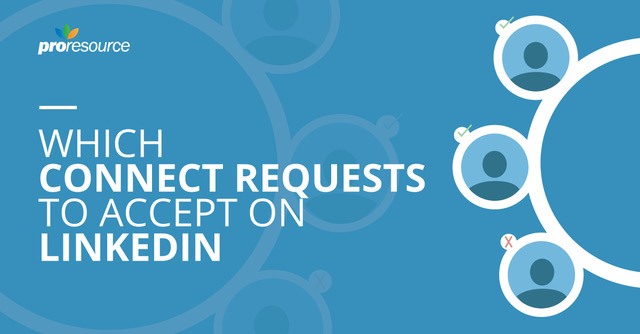
To accept, or not accept? That is the question.
It’s one of the top issues our clients want to discuss: Which connect requests should you accept on LinkedIn? And which ones should you take a pass on?
Before we dive into who you should bring into your network, let’s take a quick look at what makes a connection on LinkedIn.
How It Works
LinkedIn is a professional networking site, and it places value on engagement among its users. When you are connected to people on LinkedIn, they are your first-degree connections — and part of your network. People who are connected to your first-degree connections, but not connected to you, are your second-degree connections.
Your third-degree connections are the people who are connected to your second-degree connections. If you have 43 connections, and most of the people in your network have 500 or fewer, your third-degree connections might number a few thousand.
Those are pretty much the only people who can find you on LinkedIn, unless someone searches for you on Google or has a higher (paid) version of LinkedIn. If you have a larger network, you might have 20+ million people within three degrees, but it still isn’t close to LinkedIn’s full 650 million members.
Who Should I Definitely Connect With?
Let’s start off with the connections that are easy to determine. Accept connect requests from current co-workers, mentors, customers, partners, and classmates. If you have a positive business relationship with a person, connect with them on LinkedIn. Also consider connecting with former co-workers if you worked together well.
If people in any of these categories haven’t sent you a connect request, go ahead and initiate the online relationship. Connecting only with people you know will keep your network tight-knit and meaningful.
The size of your network does matter, but your network’s size should be balanced with a consistent approach that helps you make quality connections.
Who Should I Avoid?
Most of us have had at least one business relationship go south. And let’s face it, we also enjoy some of our contacts more than others. If you don’t want to hear what someone has to say, or you’re worried they’ll say something not in line with your own professional values, don’t connect with them. If you cringe when the connect request pops up on your screen, that’s usually a sign your LinkedIn relationship isn’t meant to be.
Avoid connect requests that are obvious sales pitches. In a lot of ways, the direct sales approach on LinkedIn is even lazier than cold calling. While we all might hope to expand business through our online connections, a good salesperson knows relationships matter.
The Big, Gray In Between
This is where most of your connect requests will come from. Fortunately, we have some solid questions for you to ask yourself when you grow your network.
-
- When you receive a connect request from a second-degree connection, evaluate the relationships you have with mutual connections. Are you closely aligned with those shared acquaintances?
- Do you believe you can form a positive and complementary relationship with the person?
- Can the person provide a viewpoint that you think you need to hear, even if you don’t agree with it?
- Do you share professional values and commitments, such as advocacy, the issues you discuss online, and the causes you support?
- Is this person a thought leader in your field?
What About Your Unusual Uncle Homer or Mad Aunt Marge?
LinkedIn is NOT Facebook. And that’s actually your “out” when it comes to ignoring some connect requests. So when Uncle Homer or Aunt Marge asks why you didn’t accept their request, your answer is simple and honest: “LinkedIn is for my professional relationships.”
What Are Best Practices for Growing Your Network on LinkedIn?
-
- John Doe is your neighbor, but should you connect with him on LinkedIn?
- How do you break up a bad relationship on LinkedIn?
- Why is 500 connections an important milestone for your LinkedIn network?
- Should you click the “Ignore” button on an unwanted request, or simply ignore the message?
- What privacy settings impact the connect requests you receive?
We can answer all these questions — and more — when you schedule a free consultation.
In the meantime, with some critical thinking, you can ensure your network grows in a meaningful way and advances your professional goals.

